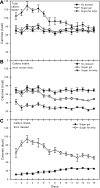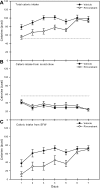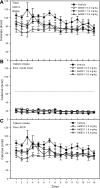Cannabinoid-1 receptor antagonists reduce caloric intake by decreasing palatable diet selection in a novel dessert protocol in female rats
- PMID: 18448611
- PMCID: PMC2494824
- DOI: 10.1152/ajpregu.00150.2008
Cannabinoid-1 receptor antagonists reduce caloric intake by decreasing palatable diet selection in a novel dessert protocol in female rats
Abstract
Although many feeding protocols induce obesity, few use multiple foods to analyze diet selection within a single group of animals. To this end, we describe a protocol using time-limited access to a dessert that induces hyperphagia and body weight gain while allowing simple analysis of diet selection. Female retired breeder Sprague-Dawley rats were provided with ad libitum access to standard moist chow (1.67 kcal/g) and daily 8-h nocturnal access to either a sugar gel (SG; 0.31 kcal/g) or sugar fat whip (SFW; 7.35 kcal/g) for 15 days, and food intake and body weight were measured daily. Rats given SFW reduced moist chow intake but not enough to compensate for the large amount of calories consumed from SFW, and thus gained weight. We use this SFW overconsumption protocol to investigate the hypothesis that cannabinoid (CB)1 receptor antagonists reduce caloric intake by selectively decreasing consumption of palatable foods. In two experiments, female retired breeder Sprague-Dawley rats were injected with either Rimonabant (1 mg/kg ip) or vehicle (equal parts polyethylene glycol and saline, 1 ml/kg ip) for 7 days, or one of three doses of AM251 (0.3, 1.0, or 3.0 mg/kg ip), or vehicle for 15 days; food intake and body weight were measured daily. Both Rimonabant and AM251 decreased 24-h caloric intake, but the reduction was specific to a decrease in SFW consumption. This supports the hypothesis that these CB1 receptor antagonists impact feeding by modulating the perception of palatability.
Figures






Similar articles
-
Selection of a palatable dietary option is not preferentially reduced by cannabinoid CB1 receptor antagonist AM251 in female C57Bl/6J mice.Pharmacol Biochem Behav. 2009 Nov;94(1):119-23. doi: 10.1016/j.pbb.2009.07.016. Epub 2009 Aug 4. Pharmacol Biochem Behav. 2009. PMID: 19660493
-
The inverse agonist of CB1 receptor SR141716 blocks compulsive eating of palatable food.Addict Biol. 2014 Sep;19(5):849-61. doi: 10.1111/adb.12056. Epub 2013 Apr 16. Addict Biol. 2014. PMID: 23587012 Free PMC article.
-
The cannabinoid CB1 receptor inverse agonist, rimonabant, modifies body weight and adiponectin function in diet-induced obese rats as a consequence of reduced food intake.Pharmacol Biochem Behav. 2006 Jun;84(2):353-9. doi: 10.1016/j.pbb.2006.06.001. Epub 2006 Jun 30. Pharmacol Biochem Behav. 2006. PMID: 16814374
-
Efficacy of rimonabant and other cannabinoid CB1 receptor antagonists in reducing food intake and body weight: preclinical and clinical data.CNS Drug Rev. 2006 Summer;12(2):91-9. doi: 10.1111/j.1527-3458.2006.00091.x. CNS Drug Rev. 2006. PMID: 16958983 Free PMC article. Review.
-
Central versus peripheral antagonism of cannabinoid CB1 receptor in obesity: effects of LH-21, a peripherally acting neutral cannabinoid receptor antagonist, in Zucker rats.J Neuroendocrinol. 2008 May;20 Suppl 1:116-23. doi: 10.1111/j.1365-2826.2008.01693.x. J Neuroendocrinol. 2008. PMID: 18426510 Review.
Cited by
-
Exposure to a Highly Caloric Palatable Diet during the Perinatal Period Affects the Expression of the Endogenous Cannabinoid System in the Brain, Liver and Adipose Tissue of Adult Rat Offspring.PLoS One. 2016 Nov 2;11(11):e0165432. doi: 10.1371/journal.pone.0165432. eCollection 2016. PLoS One. 2016. PMID: 27806128 Free PMC article.
-
Rimonabant's reductive effects on high densities of food reinforcement, but not palatability, in lean and obese Zucker rats.Psychopharmacology (Berl). 2014 May;231(10):2159-70. doi: 10.1007/s00213-013-3366-4. Epub 2014 Jan 8. Psychopharmacology (Berl). 2014. PMID: 24398820 Free PMC article.
-
The endocannabinoid system: potential for reducing cardiometabolic risk.Obesity (Silver Spring). 2009 Oct;17(10):1821-9. doi: 10.1038/oby.2009.107. Epub 2009 Apr 16. Obesity (Silver Spring). 2009. PMID: 19373218 Free PMC article. Review. No abstract available.
-
The Influence of Palatable Diets in Reward System Activation: A Mini Review.Adv Pharmacol Sci. 2016;2016:7238679. doi: 10.1155/2016/7238679. Epub 2016 Mar 20. Adv Pharmacol Sci. 2016. PMID: 27087806 Free PMC article. Review.
-
A novel fluorophosphonate inhibitor of the biosynthesis of the endocannabinoid 2-arachidonoylglycerol with potential anti-obesity effects.Br J Pharmacol. 2013 Jun;169(4):784-93. doi: 10.1111/bph.12013. Br J Pharmacol. 2013. PMID: 23072382 Free PMC article.
References
-
- Arnone M, Maruani J, Chaperon F, Thiebot M, Poncelet M, Soubrie P, Le Fur G. Selective inhibition of sucrose and ethanol intake by SR 141716, an antagonist of central cannabinoid (CB1) receptors. Psychopharmacology 132: 104–106, 1997. - PubMed
-
- Berridge KC, Pecina S. Benzodiazepines, appetite, and taste palatability. Neurosci Biobehav Rev 19: 121–131, 1995. - PubMed
-
- Chambers AP, Sharkey KA, Koopmans HS. Cannabinoid (CB)1 receptor antagonist, AM 251, causes a sustained reduction of daily food intake in the rat. Physiol Behav 82: 863–869, 2004. - PubMed
-
- Colombo G, Agabio R, Diaz G, Lobina C, Reali R, Gessa GL. Appetite suppression and weight loss after the cannabinoid antagonist SR 141716. Life Sci 63: PL113–PL117, 1998. - PubMed
Publication types
MeSH terms
Substances
Grants and funding
LinkOut - more resources
Full Text Sources

